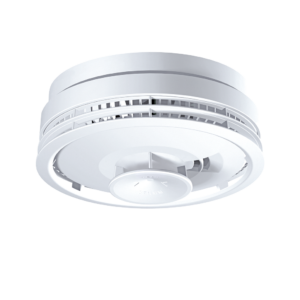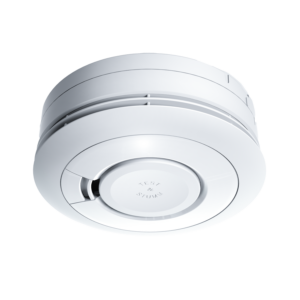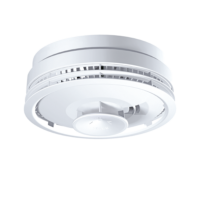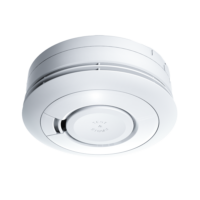Q smoke
Smoke alarms from QUNDIS
Smoke alarms, also referred to as ‘fire alarms’, detect smoke and sound the alarm in the event of a fire: They attract the attention of anyone in the vicinity with a loud beeping noise and a visual signal.
In Europe smoke alarms must comply with the EN 14604 certification standard. This standard contains the following provisions:
- The smoke must be able to penetrate into the device from all sides.
- The openings for the smoke must not be wider than 1.3 mm. This prevents any dirt from penetrating.
- The sound level of the alarm must be at least 85 dB at a distance of 3 m.
- If the batteries run down the smoke alarm must emit a warning sound at least 30 days before the necessary battery replacement.
- It must also be possible to test the functions of the smoke alarm.
Smoke alarms from QUNDIS goes beyond the required functional scope. It combines innovative electronics with minimum size and maximum reliability. By means of a photoelectric process the device quickly identifies hazardous concentrations of smoke, and sounds an acoustic alarm in the event of a fire.
Because smoke alarms are naturally subject to the accumulation of dirt, their functional capacity diminishes over the years. This is not the case with our products! Our devices compensate for any accumulation of dirt by automatically adjusting the basic signal. This provides them with two and a half times the product life of smoke alarms without this compensation function. Thus, false alarms will be avoided for the most part. Thanks to the integrated battery, the QUNDIS smoke alarms achieves a durability of at least 10 years.
The result: smoke alarms from QUNDIS is 100% reliable and in addition fulfils strict quality requirements.
Sales hotline
+49 361 26 280-0
We are there for you
Mo – Fr from
8 – 17 hrs.

Smoke alarm Ei6500-OMS
Safety & ease of operation in perfect harmony.
The Ei6500-OMS expands the QUNDIS portfolio with a 4th generation wireless smoke alarm in accordance with the OMS standard. With the permanently installed 3V lithium battery as well as the wM-Bus remote inspection module, this smoke alarm is ideally suited for entirely remote inspection in accordance with DIN 14676-1 Method C.
Thanks to the regular, automatic functional self-test as well as wireless radio transmission, an annual on-site inspection is no longer necessary, as the relevant data can be conveniently transmitted remotely at any time. For example, data relating to the energy supply, smoke sensors or disassembly as well as other status messages that are functionally important. Existing processes can be simplified in this way, thus saving costs.
System integration is extremely simple: after being screwed into the base, the smoke alarm automatically goes into operation and sends data telegrams to the QUNDIS Q AMR or Q walk-by system. The high security standard is guaranteed by the AES-128 data encryption according to OMS-Encryption Mode 5.
With QUNDIS and the Q SMP, key management is also uncomplicated. After you place your order, you will receive an electronic QUNDIS delivery note (eLS, csv file) by email. After successful eLS import, automatic decryption can then be carried out in the Q SMP. All you need is a corresponding Q SMP tariff from QUNDIS.
Product flyer
(PDF file)

The Ei650i smoke alarm
Reliable and safe.
The Ei650i stand-alone smoke alarm is a real star in terms of quality and reliability, and has already proven itself in use millions of times over. In addition to the EN 14604 product standard, it also complies with vfdb directive 14/01 and therefore meets the strict requirements of the “Q” seal (tested and certified by VdS, test number G211009). It is thus one of the leading quality products on Germany’s smoke alarm market.
In order not to disturb the night’s rest of occupants, unwanted LED flashing is suppressed. The smoke alarm also has integrated dirt compensation and, in addition to the proven features of the Ei650, has additional functions such as an extended muting function and special diagnostic features.
It can be mounted directly on the ceiling using one or two screws. Alternatively, the Ei650i can be fitted to the existing Ei smoke alarm mounting plates of the Ei650 or Ei605 series.
Product flyer
(PDF file)
QUNDIS is involved in the “Smoke alarms save lives” initiative
As a supplier of premium-quality smoke alarms we are actively involved in the “Smoke alarms save lives” initiative organised by ‘Forum Brandrauchprävention e. V’. This organisation campaigns not only to ensure that all households are fitted with smoke alarms, but also for the promotion of quality standards. For further information please see the online platform: www.rauchmelder-lebensretter.de
FAQs about smoke alarms
Our smoke alarms work on the scattered light principle. When smoke exceeds a certain concentration, the light in the device is directed to a photocell and triggers the acoustic alarm. Via the test button on the smoke alarm Ei650i it is possible to check, for example, whether one or more alarms have been triggered within the last three months. In addition, the LED light flashes and signals the status. For optimal protection, you should install a smoke alarm in all rooms where a fire could possibly break out (with the exception of the kitchen and bathroom).
The DIN 14676 national application standard regulates the planning, installation, operation and maintenance of smoke alarms. This standard applies to private homes and rooms with residential-like use. It is addressed to the authorities responsible for fire protection, fire departments, manufacturers of smoke alarms, planners, homeowners and residents. Important information: only smoke alarms that meet the requirements of EN 14604 may be used in the EU.
In addition, the building codes (LBO) of the federal states regulate the obligation to equip existing and new buildings with smoke alarms.
Before smoke alarms became popular in the domestic sector, in Germany there were almost exclusively fire detection systems (e.g. in hospitals, warehouses, hotels). Early on the government created a corresponding standard in which the detectors were referred to as smoke alarms. However, the function of these detectors is not only to warn people of dangerous smoke concentrations by loud beeping, but also to report a fire directly to the fire department – even if there are no people in the building.
As smoke alarms became more widespread in homes, it was discovered that the name was already taken. From then on, the acoustic warning devices were referred to as “smoke alarms”. Even if in common usage we talk about smoke detectors, in most cases we are talking about smoke alarms. Our portfolio contains only such smoke alarms.
Please note that the service life of a smoke alarm is 10 years. This extensive operating time is achieved by a permanently installed lithium battery and increases safety. It also saves you having to change the battery regularly. In addition, a CE marking must be available. This proves that the smoke alarm complies with the European EN 14604 standard and has been tested and approved according to the strict criteria of the standard.
The coveted VdS test seal is only awarded to devices that meet the particularly strict “Q” standards. The “Q” stands for the highest quality of smoke alarms . It provides information on whether a smoke alarm is suitable for long-term use of 10 years
The DIN 14676 application guidelines prescribe how smoke alarms are to be installed. The following table provides an initial overview of some of the most important specifications:
| Where? | On the ceiling |
| Position? | If possible, in the middle of the ceiling (a minimum distance of 50 cm must be maintained from all fixtures and fittings on the ceiling and walls). |
| How high? | Max. 6 m room height |
| What area is monitored? | Max. 60 m² |
| Operating temoerature range: | 0°C – 55°C |
Important: the smoke alarms from QUNDIS equipped with the radio module do not replace a central fire alarm system. If, in the event of smoke or fire detection, alarm forwarding to the fire department is desired or required, central fire alarm systems in accordance with DIN 14675 must be used.
Smoke alarms are not suitable for bathrooms or closed kitchen rooms. The distance from kitchen doors, bathroom doors, the compressed air lines of air conditioners or heaters, ceiling fans and other fans must be at least 90 cm.
The smoke alarms should also not be installed in very dusty areas (e.g. workshops). In the case of renovation work involving a high level of dust generation, you should cover the smoke inlet openings of the smoke alarms until the end of the work, or remove the smoke alarms completely. Never paint over smoke alarms!
When the test button is pressed, the indicator light flashes regularly to show that the smoke alarm is working. With the Ei650i, the LED is automatically reduced from 10 p.m. to 6 a.m.. With the Ei6500-OMS there is no signalling during normal operation. During this time, fault messages are suppressed on the Q smoke Genius H or permanently signalled on the Ei6500-OMS. In the event of an emergency, an alarm is still triggered.
When the Ei650i or the Ei6500-OMS are screwed into the mounting socket the device is activated automatically. An acoustic signal sounds after the unit is locked into place, confirming that it is ready for operation.
During remote inspection, the smoke alarm sends the necessary status information about its operating condition via radio to the radio network in the building. With this information, the owner of the building can detect at a very early stage whether a device is faulty. The replacement can then take place directly, e.g. in the course of the annual visual inspection.
The following handling and operating status messages are transmitted by the Ei6500-OMS radio smoke alarms to the remote meter reading system:
- Date and time of the device
- Date of first use
- Date of the most recent acoustic test and status
- Degree of dirt in the smoke chamber
- Battery voltage and the end of life (10 years) reached
- Sensor error
- Error in the obstacle detection system
- Change in surroundings detected since installation
- Obstacle detection not possible due to interference
- Communication detector / OMS module disrupted
- Detector completely covered
- “Smoke alarm” frequency and most recent date
- Frequency, total duration and last date of “Detector removed”
- Frequency and last date of “Test button pressed”
Quality smoke alarms, such as those from QUNDIS, do not register cigarette smoke as a hazard because they can detect the difference between it and very small but dangerous smoke concentrations. Thanks to the dirt compensation function, this mechanism works reliably throughout the entire service life of the device.
Dirt compensation
Our smoke alarms constantly monitor any dirt and dust within their measuring chamber. If dirt particles are detected in the chamber, their alarm threshold is adjusted so that the distance to the basic signal always remains the same. The smoke alarms from QUNDIS do not become more sensitive due to dirt, with the result that their operating time is increased many times over. In this way, false alarms can be avoided as far as possible.
Dirt forecasting
Our smoke alarms can determine the condition of their measuring chamber by means of the so-called alarm threshold tracking. For this purpose the device measures at regular intervals how heavily the measuring chamber is clogged with dirt particles – the greater the amount of dirt, the more the alarm threshold is lowered. During the annual function test, the devices automatically make a forecast as to whether they will be able to function for another 15 months if the level of dirt remains the same. If they determine during the forecast that the dirt level in the measuring chamber is so high that the alarm threshold can no longer be readjusted, the function test will be negative.




